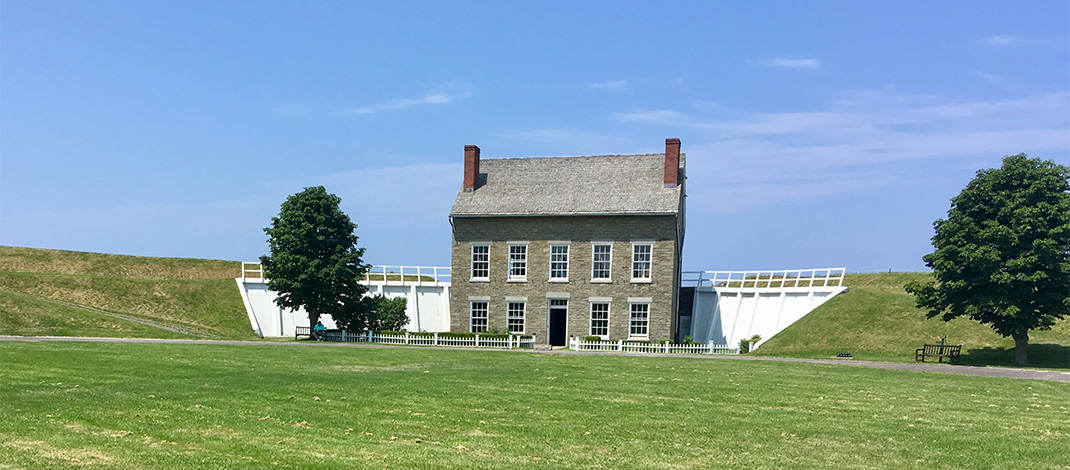By Ken Sturtz
After struggling with funding for years, the popular Oswego historic site has more staff and is working on new research and programming
The gates of the stone fort were closed and locked and the lawn outside resembled an un-mowed hay field. It was 2010 and the state, facing a multi-billion-dollar budget gap, had closed more than 50 parks and historic sites.
At Fort Ontario State Historic Site money for staff, programming and repairs disappeared. The heat was even turned off in one of the historic buildings.
Public outcry led the state to reopen the closed sites, but many continued operating on shoestring budgets. Buildings remained closed and exhibits dismantled. Positions went unfilled and historical research and interpretation took a backseat.
Simply maintaining the buildings at Fort Ontario proved daunting because the elements extract a heavy toll at the site, which sits on a bluff overlooking Lake Ontario.
“We kept it stable, we did limited programming,” said Paul Lear, the longtime site manager. “It was a struggle to keep the facilities going.”
Today, however, Fort Ontario is in the midst of a revitalization.
New staff have been busy increasing the fort’s social media presence, expanding programming and processing a backlog of donated artifacts. Rooms that had been left empty are being furnished and exhibits and displays updated. Workers are digitizing troves of research and conducting new research.
In the decade since it was closed, the state has invested hundreds of thousands of dollars in the fort’s infrastructure, from replacing roofs and renovating bathrooms, to fixing drainage problems and installing new furnaces and lighting.
But Lear said that more recently the biggest change has been Gov. Kathy Hochul’s efforts to increase funding for the state’s parks and historic sites. In addition to money for capital projects, many long unfilled positions have been filled.
“The governor has breathed new life into our historic sites and parks,” he said. “We’re able to provide better services for years to come.”
The first fort on the site was built by the British in 1755. It saw action during the French and Indian War and the War of 1812 and was repeatedly destroyed. The present-day fort was built in the 1840s. Major improvements ceased after 1872. The fort was eventually abandoned, but an Army post sprung up, serving as a hospital in World War I. It continued to be used during World War II and served as the only refugee camp in the U.S. for Holocaust victims.
Staffing shortages were especially acute at the fort, which attracted more than 108,000 visitors in 2021. Previously there were just two full-time, year-round employees besides Lear. The rest work seasonally from May to October.
In December Lear was finally able to fill the fort’s site assistant position, which the state had left vacant for 11 years. He said that alone has made an incredible difference. Danielle Funiciello is an experienced curator who has worked at the Schuyler Mansion State Historic Site and the New York State Museum in Albany.
She is handling projects such as improving care and organization of the fort’s stored collections, digitizing documents, updating period furnishings in rooms, and expanding exhibits. Lear said she’s also increasing the use of social media and video in the fort’s programming.
Other duties include organizing, maintaining and making interpretive clothing and equipment. Funiciello, a seamstress, is making many of the authentic uniforms and dresses visitors see interpreters wearing. And the fake bread in the fort kitchen display? She’s making that too.
The fort is in the middle of digitizing its massive collection of research files. The state is digitizing the fort’s museum collections but not the research files, which consist of thousands of manila folders in more than 40 file drawers and are difficult to organize because they cover multiple wars and several hundred years.
The Friends of Fort Ontario helped acquire and install a computer, scanners and software and obtained a grant to hire a former intern to work on the digitization project. When completed the files will be searchable by keyword and enable staff to easily locate information on everything from the mundane (what kind of socks were issued to the troops) to the tragic (soldier injuries).
“It’s really going to help us out in the future,” Lear said.
The friends group also funded two AmeriCorps positions earlier this year. One researched and produced a public program and guide to military memorial monuments in Oswego. Another did research for a guided walking tour called “Murder, Mysteries, Mishaps, and Mayhem at Fort Ontario, 1755 to Yesterday.”
In the past staff have researched the fort and the people who lived there using traditional sources, such as the fort’s own archives of historic documents. But with vast amounts of documents being digitized and made easily accessible online, it’s possible to find new information.
For example, a staff member is in the process of researching the lives of the soldiers stationed at Fort Ontario in 1868 (the fort today appears much as it did during that period). Most were Civil War veterans and the researcher has dug up interviews with the men, photographs of some and details of their lives after leaving the military.
“We have far more research than we did years ago,” Lear said. “This is what humanizes these people.”
Disciplinary records, for example, provide accounts of what happened when men were charged with drunkenness or insubordination. In one case, a researcher found documents regarding a laundress who wasn’t paid by a soldier for her work.
“She wanted her money so she filed charges and took him to court,” Lear said.
With the addition of more staff the fort is working through a sizable backlog of artifact donations. The fort was able to establish a collections work area in an unused portion of a building to process and store artifacts. Each donation has to be photographed and catalogued before a curator can assess its condition and research the object. Eventually they decide whether the object is part of the fort’s history or not.
Over the last two years donated artifacts have flooded in faster than the fort could process them, though Lear said they’re almost through the backlog. Donations have included a wide range of items from uniforms to documents.
“With COVID everyone was home and seemed to be cleaning their attics and garages and finding scrapbooks and other items,” Lear said. “It’s just a real boost to our collections.”
New artifacts and research have a subtle, but significant impact on visitor experience. Decades ago most of the buildings and casemates at the fort weren’t open to the public. Lear has overseen their gradual opening. Research helped ensure rooms were furnished with authentic items and looked as they would have historically.
Today artifacts and research are giving staff more insight into what life was like for the people who lived at Fort Ontario, which in turn affects how exhibits and programs are designed.
That’s especially important at a place like Fort Ontario. The historic site encompasses so many different periods of history — many visitors, for example, are unaware of the site’s role in sheltering Holocaust survivors — that it is a challenge to interpret it all, Lear said.
“Here at the fort we don’t ask what time it is when we roll out of bed,” he said. “It’s more like what war are we interpreting today.”



